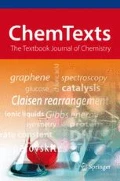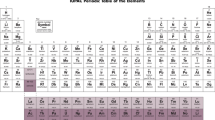Abstract
A condensed overview about the forefathers’ and Mendeleev’s contribution to the compilation of the Periodic Table of Chemical Elements is presented. Milestones en route to the modern Periodic Table are ‘electrification’ of the Periodic Law, discovery of the rare-earth elements and the noble gases, investigation of the atomic structure and discovery of the transuranic elements. Then the contribution focuses on the Table’s short form as toolbox for learning the basics of inorganic chemistry. Similarities and differences in the chemical behavior of elements on the basis of full, close and approximate electronic analogies and the kainosymmetric sublevels (1s, 2p, 3d, 4f) are described. A question/answer section completes the article.





Similar content being viewed by others
Change history
23 April 2020
We regret that Table��2 did not list all 118 elements of Mendeleev���s Periodic Table.
Notes
The modern definition of the atomic mass (often incorrectly called ‘atomic weight’) is the average mass of all naturally occurring isotopes of an element. Since 1961 the atomic mass unit (amu) is defined using carbon’s most common isotope 12C as the reference standard. The molar mass (g mol−1) is defined as the amount of a given substance (chemical element or chemical compound) per mole (6.022 × 1023) atoms or molecules.
Orbitals which have the least value of (n+ℓ) will be filled first with electrons. If there are two orbitals that have the same value of (n+ℓ), then the orbital that has the least value of ‘n’ will be filled first. ‘n’ is the principal quantum number and ‘ℓ’ the orbital angular momentum quantum number.
The nucleus of a heavy element captures the inner electron, one of the protons transforms to a neutron and the atomic number is reduced by one.
References
Jensen WB (2000) The periodic law and table, written for britannica on line. http://www.che.uc.edu/jensen/w.%20b.%20jensen/reprints/081.%20Periodic%20Table.pdf. Accessed 2017
A brief history of the development of Periodic Table. https://www.wou.edu/las/physci/ch412/perhist.htm. Accessed 2017
Julius LM, Dmitri IM https://www.chemheritage.org/historical-profile/julius-lothar-meyer-and-dmitri-ivanovich-mendeleev. Accessed 2017
How exactly did Mendeleev discover his Periodic Table of 1869? https://blog.oup.com/2012/08/how-exactly-did-mendeleev-discover-his-periodic-table-of-1869/. Accessed 2017
De Laeter JR, Böhlke JK, De Bièvre PP, Hidaka H, Peiser HS, Rosman KJR, Taylor PDP (2003) Pure Appl Chem 75:683–800. http://www.ciaaw.org/pubs/EXER-2000.pdf. Accessed 2017
Meija J, Coplen TB, Berglund M, Brand WA, De Bièvre P, Gröning M, Holden NE, Irrgeher J, Loss RD, Walczyk T, Prohaska T (2016) Pure Appl Chem 88:265–291. http://nparc.nrc-cnrc.gc.ca/eng/view/fulltext/?id=23a71e6c-605b-458b-b56e-5efb0a347895. Accessed 2017
Meyer L (1864) Die modernen Theorien der Chemie (Modern chemical theories). Maruschke & Behrends, Breslau
Mendelejeff D (1869) Zeitschrift für Chemie 12:405–406
Ueber die Beziehungen der Eigenschaften zu den Atomgewichten der Elemente. Translation of Medeleev’s publication into English: On the relation of the properties to the atomic weights of the elements. https://web.lemoyne.edu/giunta/EA/MENDELEEVann.HTML. Accessed 2017
Meyer L (1870) Die Natur der chemischen Elemente als Funktion ihrer Atomgewichte (The nature of the chemical elements as function of their atomic weights). Lieb Ann Suppl VII:354–364
Haustein M (2004) Clemens Winkler—chemistry was his life (in German). Wissenschaftlicher Verlag Harri Deutsch GmbH, Frankfurt am Main
Hargittai I (2002) The road to stockholm: nobel prizes, science, and scientists. Oxford University Press, Oxford
The genius of Mendeleev’s Periodic Table—Lou Serico. https://www.youtube.com/watch?v=fPnwBITSmgU. Accessed 2017
Martyn P (1947 – living ) discusses the paths to elements 119 and 120 (published on 15 May 2017). https://www.youtube.com/watch?v=SBz_NDq6g6E. Accessed 2017
http://physicsworld.com/cws/article/news/2018/jan/17/chemists-gear-up-for-2019-international-year-of-the-periodic-table. Accessed 2017
Periodic Table variations. https://images.search.yahoo.com/yhs/search;_ylt=A0LEVi7VNzNaE8wAFyAPxQt.;_ylu=X3oDMTByMjB0aG5zBGNvbG8DYmYxBHBvcwMxBHZ0aWQDBHNlYwNzYw--?p=periodic+table+variations&fr=yhs-Lkry-SF01&hspart=Lkry&hsimp=yhs-SF01. Accessed 2017
Periodic Table poster. https://www.ptable.com. Accessed 2017
Periodic Table. https://www.inorganicventures.com/periodic-table. Accessed 2017
Periodic Table. http://www.periodictable.com. Accessed 2017
Periodic Table. http://www.rsc.org/periodic-table. Accessed 2017
Periodic Table. https://www.chemicool.com. Accessed 2017
https://iupac.org/what-we-do/periodic-table-of-elements/. Accessed 2017
Ugai YaA (1989) Inorganic chemistry (in Russian). Высшая школа (Vysshaya Shkola), Moscow
Imyanitov NS (2016) Found Chem 18:153. https://doi.org/10.1007/s10698-015-9246-8
Acknowledgements
The authors are indebted to Prof. Dr. Fritz Scholz for his invaluable discussions and stimulating ideas.
Author information
Authors and Affiliations
Corresponding author
Rights and permissions
About this article
Cite this article
Andriiko, A.A., Lunk, HJ. The short form of Mendeleev’s Periodic Table of Chemical Elements: toolbox for learning the basics of inorganic chemistry. A contribution to celebrate 150 years of the Periodic Table in 2019. ChemTexts 4, 4 (2018). https://doi.org/10.1007/s40828-018-0059-y
Received:
Accepted:
Published:
DOI: https://doi.org/10.1007/s40828-018-0059-y




